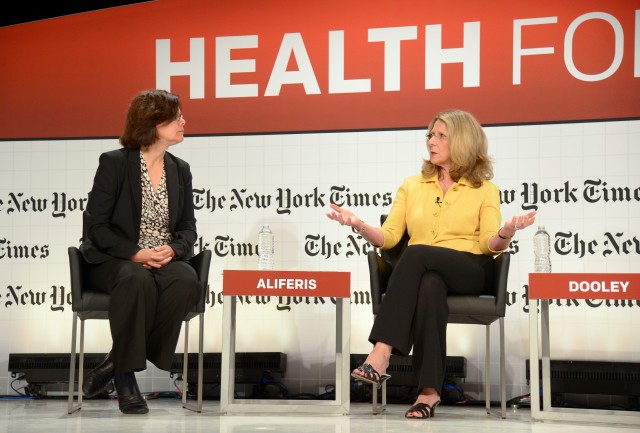Together the changes required in those three areas have brought about "disruptive innovation," she argued.
We have really disrupted the system in ways that we can't completely predict what the result is going to be. I'm reminded of a quote from Albert Einstein … [he said] after the atomic bomb, 'Everything changed, save our way of thinking.' Sometimes I think about that and where we are with the Affordable Care Act: Everything has changed, save our way of thinking.'
The system has changed for everyone, Dooley said, for providers, for health plans and for consumers. "People are complaining that they're being forced to change," she said. "They want to keep what they have, but then they complain that they don't like what they have either."
A major criticism of Covered California has come from people finding it hard to find a doctor who accepted their insurance. Dooley said Covered California was paying attention to the adequacy of provider networks and had worked with plans on this question:
We've already seen in the last two months, with the plans expanding their networks, where we've shown that they didn't have enough physicians or there wasn't enough choice. Some of the providers themselves, the hospitals and the doctors, are coming back to the plans and now negotiating to get back in. They're seeing the success; they're seeing how many new lives (are) covered, how many new patients they can get. ... It's going to take us a couple years at least to settle into a different relationship between the doctors, the plans, the hospitals and the referral systems for care.
Dooley spoke with enthusiasm about California being one of just a handful of states participating in an ACA pilot program to coordinate the care of "dual eligibles," vulnerable seniors and disabled people eligible for both Medi-Cal and Medicare. This population often has the most fragmented care.
So we're working in a pilot to begin to bring that together. We've got in the provider community people who treat Medi-Cal patients and people who treat Medicare patients, and they don’t talk to each other. … We will have to push the system to create this integration and the coordination of care. … We learned a lot during the '90s with the managed care effort, but we put all this responsibility then with the insurance plans, and there was a very bad reaction to that where people just thought the management of care was the denial of care.
People view health insurance differently from other kinds of insurance, Dooley said.
People don't think of health insurance like they do other indemnity products. You don't hope your house burns down to take advantage of your homeowners insurance. You don't hope you get in a wreck to take care of your auto insurance. But you expect to use your health care insurance. It's partly indemnification and it's partly prepaid plan, so we have a different relationship with our health insurance and our health delivery, and there are opportunities within (the ACA) to give us the tools to make changes to that system, and we're doing that.
Looking back to 2010-11, California was more successful in implementing the ACA at least in part because the issue "was not as partisanly charged" here, Dooley said. The law was "embraced by a Republican governor" — referring to Gov. Schwarzenegger — but Dooley also reminded the audience that the fiscal outlook was grim in 2011 when Gov. Jerry Brown came into office and appointed Dooley to her post.
For the first couple of years we were working on a conditional basis. We were preparing to implement the Affordable Care Act if we could get our fiscal house in order in California. I mention that because I think we were proceding with a great deal of humility. We knew that there were opportunities the Affordable Care Act created, but we also knew that it wasn't reasonable to expect people to believe that we could go forward at the same time we were going backward, to have the kind of expansion of coverage that the Affordable Care Act allowed at the same time we were significantly cutting programs and services. And the Health and Human Services Agency alone, in the first two years of the Brown administration, we cut $2 billion out of our programs.
